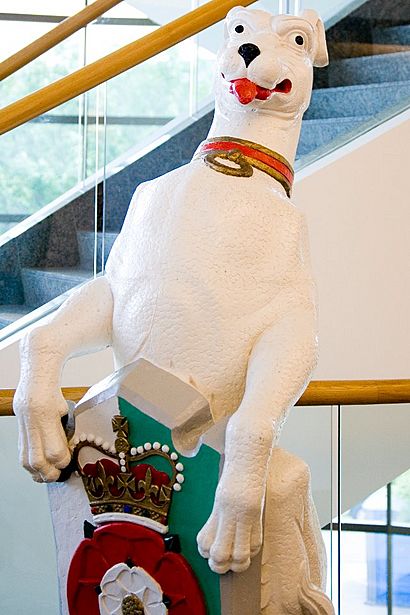White Greyhound of Richmond facts for kids
Quick facts for kids The White Greyhound of Richmond |
|
|---|---|
 |
|
| Artist | James Woodford |
| Year | 1953 |
| Type | Sculpture |
| Medium | Plaster |
| Dimensions | 213 cm × 91.5 cm × 91.5 cm (84 in × 36.0 in × 36.0 in) |
| Location | Canadian Museum of History, Gatineau |
| Owner | Government of Canada |
| Accession | 980.9.6 |
| Website | http://www.historymuseum.ca/collections/artifact/132923 |
The White Greyhound of Richmond is a famous sculpture. It is one of the ten "Queen's Beasts" created for Queen Elizabeth II's coronation in 1953. These beasts are symbols of the royal family's history. You can find a stone copy of this greyhound at the Royal Botanic Gardens, Kew in England.
What Does the White Greyhound Symbolize?
The White Greyhound of Richmond holds a shield. This shield shows the Tudor family's colors, which are white and green. On the shield, you will see a Tudor Rose with a royal crown on top.
King Henry VII of England often used greyhounds as symbols. His father, Edmund Tudor, was given the title of Earl of Richmond. Because of this, the white greyhound became connected to the Richmond area. The Tudor Rose itself is a special symbol. It combines the red rose of the House of Lancaster and the white rose of the House of York. This shows how these two rival families were united through marriage.
The History of the White Greyhound
The White Greyhound was first used as a symbol by John of Gaunt, 1st Duke of Lancaster. This was back in the 1300s when he was in charge of the Richmond area. Greyhounds were very popular dogs in Northern England at that time.
Over time, this animal symbol was also used by other important figures. It was meant to represent the honor and importance of Richmond, no matter who was in charge.
The symbol became very important to the Tudor dynasty. King Henry VII, who founded the Tudor family, was a key member of the House of Lancaster. He used the White Greyhound to show his connection to Richmond. He even replaced the English lion with the White Greyhound on one side of the coat of arms of England, placing it opposite the Welsh dragon (Y Ddraig Goch). This change helped to strengthen his claim to the throne and show the new unity of England under the Tudors.


